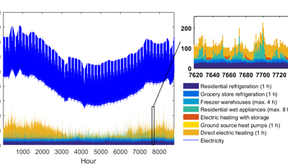Cities show significant energy flexibility potential

Urban areas cause two-thirds of global energy consumption and the related CO2 emissions, and will become even more important with the rapid urbanization. Clean energy use in cities is therefore instrumental to climate change mitigation. For example Helsinki and Copenhagen have already set ambitious emissions targets, aiming at carbon neutrality by 2050 and 2030.
Solar and wind power are well-suited for clean energy production in urban areas, but they are also variable which requires more flexibility in energy systems. At the same time, urban areas present interesting flexibility opportunities in electricity and heat consumption. Researchers at the New Energy Technologies group at Aalto University have developed new simulation models for quantifying the technical and economic flexibility potential of electricity demand side management, and power-to-heat conversion with electric boilers and heat pumps. The models can be applied for any location and conditions, and could be useful in clean energy planning in cities worldwide. The relevant technical details of the studied systems are modeled diligently.
The models were applied to Helsinki, Finland. Unique empirical time series data on shiftable electricity consumption was used to quantify the shiftable share more accurately than before in a bottom-up fashion. The shiftable loads included commercial and residential refrigeration, electric heating and wet appliances, totalling at 20% of the total annual electricity consumption. Power-to-heat with thermal storage in district heating could also absorb surplus solar and wind power very effectively. For example, 50% of the electricity consumption in the city could be produced from solar and wind with all the surplus converted to heat, providing 10% of the heat consumption in the city. Electricity demand side management also significantly improved the matching of electricity consumption and solar and wind production. Power-to-heat with heat pumps and thermal storage, as well as shifting electric heating and commercial refrigeration loads were found profitable investments in today's market.
Salpakari, J., Mikkola, J., Lund, P.D., Improved flexibility with large-scale variable renewable power in cities through optimal demand side management and power-to-heat conversion, Energy Conversion and Management 2016, 126, 649-661. http://dx.doi.org/10.1016/j.enconman.2016.08.041
- Published:
- Updated:
Read more news

Get to know us: Associate Professor Maria Sammalkorpi
Sammalkorpi received her doctorate from Helsinki University of Technology 2004. After her defence, she has worked as a researcher at the Universities of Princeton, Yale and Aalto.
Aalto computer scientists in ICML 2024
Computer scientists in ICML 2024
Getting bacteria into line
Physicists use magnetic fields to manipulate bacterial behaviour